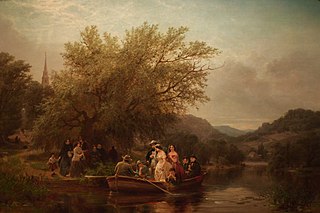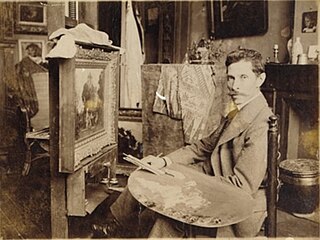Related Research Articles

Frederic Edwin Church was an American landscape painter born in Hartford, Connecticut. He was a central figure in the Hudson River School of American landscape painters, best known for painting large landscapes, often depicting mountains, waterfalls, and sunsets. Church's paintings put an emphasis on realistic detail, dramatic light, and panoramic views. He debuted some of his major works in single-painting exhibitions to a paying and often enthralled audience in New York City. In his prime, he was one of the most famous painters in the United States.

Albert Bierstadt was a German-American painter best known for his lavish, sweeping landscapes of the American West. He joined several journeys of the Westward Expansion to paint the scenes. He was not the first artist to record the sites, but he was the foremost painter of them for the remainder of the 19th century.

American Impressionism was a style of painting related to European Impressionism and practiced by American artists in the United States from the mid-nineteenth century through the beginning of the twentieth. The style is characterized by loose brushwork and vivid colors with a wide array of subject matters but focusing on landscapes and upper-class domestic life.

William-Adolphe Bouguereau was a French academic painter. In his realistic genre paintings, he used mythological themes, making modern interpretations of classical subjects, with an emphasis on the female human body. During his life, he enjoyed significant popularity in France and the United States, was given numerous official honors, and received top prices for his work. As the quintessential salon painter of his generation, he was reviled by the Impressionist avant-garde. By the early twentieth century, Bouguereau and his art fell out of favor with the public, due in part to changing tastes. In the 1980s, a revival of interest in figure painting led to a rediscovery of Bouguereau and his work. He finished 822 known paintings, but the whereabouts of many are still unknown.

Jasper Francis Cropsey was an important American landscape artist of the Hudson River School.

Asher Brown Durand was an American painter of the Hudson River School.

Jules Adolphe Aimé Louis Breton was a 19th-century French naturalist painter. His paintings are heavily influenced by the French countryside and his absorption of traditional methods of painting helped make Jules Breton one of the primary transmitters of the beauty and idyllic vision of rural existence.

Ralph Albert Blakelock was a romanticist American painter known primarily for his landscape paintings related to the Tonalism movement.

Martin Johnson Heade was an American painter known for his salt marsh landscapes, seascapes, and depictions of tropical birds, as well as lotus blossoms and other still lifes. His painting style and subject matter, while derived from the romanticism of the time, are regarded by art historians as a significant departure from those of his peers.

Albert Fitch Bellows, was an American landscape painter of the Hudson River School.

George Elgar Hicks was an English painter during the Victorian era. He is best known for his large genre paintings, which emulate William Powell Frith in style, but was also a society portraitist.

James Augustus Suydam was an American architect, lawyer, and artist; as an artist was considered one of the premier Luminism painters. He is widely known as an American landscape painter and one of the leading members of the Hudson River School.

Dennis Miller Bunker was an American painter and innovator of American Impressionism. His mature works include both brightly colored landscape paintings and dark, finely drawn portraits and figures. One of the major American painters of the late 19th century, and a friend of many prominent artists of the era, Bunker died from meningitis at the age of 29.

The American Watercolor Society, founded in 1866, is a nonprofit membership organization devoted to the advancement of watercolor painting in the United States.

Johannes Evert Hendrik Akkeringa was part of the second generation of the Hague School painters. Akkeringa is primarily known for his paintings and watercolours of women and playing children at the beach, women mending nets and intimate tea-time conversations.

The Angelus is an oil painting by French painter Jean-François Millet, completed between 1857 and 1859.

The Icebergs is an 1861 oil painting by the American landscape artist Frederic Edwin Church. It was inspired by his 1859 voyage to the North Atlantic around Newfoundland and Labrador. Considered one of Church's "Great Pictures"—measuring 1.64 by 2.85 metres —the painting depicts one or more icebergs in the afternoon light of the Arctic. It was first displayed in New York City in 1861, where visitors paid 25 cents' admittance to the one-painting show. Similar exhibitions in Boston and London followed. The unconventional landscape of ice, water, and sky generally drew praise, but the American Civil War, which began the same year, lessened critical and popular interest in New York City's cultural events.

Lefevre James Cranstone was an English artist known for his watercolor genre-style landscapes and oil paintings. He visited the United States, where many of his works are displayed, and later moved to Australia.

Virginia Granbery (1831–1921) was an American painter.
References
- 1 2 3 Silva, Francis A. (November 1885). "The Artists' Fund Society". The Art Union. 2 (5): 105–107. doi:10.2307/20443104. JSTOR 20443104.
- ↑ Stephen Ferguson (June 14, 2010). "The Artists' Fund Society of the City of New York: a recently acquired set of their sale catalogues, 1860-1889". Princeton University Rare Book Collection.
- 1 2 "Guide to the Artists' Fund Society Records: 1859-1937". New-York Historical Society.
- ↑ Constitution of the Artists' Fund Society of the City of New York. November 21, 1890.